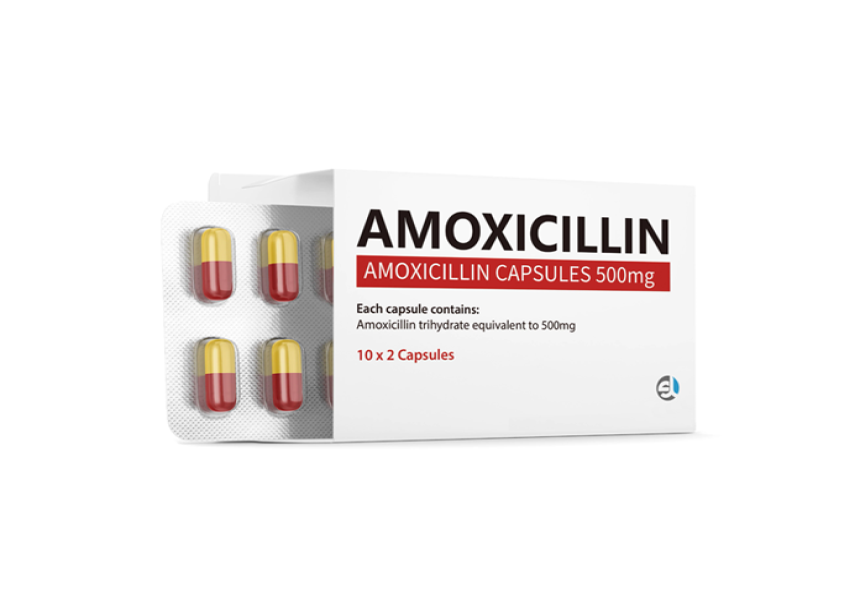
Table of contents
What is Amoxil
Amoxil, known generically as amoxicillin, is a widely used antibiotic that belongs to the penicillin class of medications. It is effective against a broad range of bacterial infections by inhibiting the growth of bacteria, making it a versatile option for treating various conditions. Amoxil is typically prescribed to treat infections caused by susceptible strains of bacteria.
This antibiotic works by interfering with the bacteria's ability to form cell walls, which are essential for their survival. Without a proper cell wall, bacteria are unable to maintain their structure and are ultimately destroyed. This mechanism of action makes Amoxil an effective treatment for many bacterial infections.
Amoxil is available in several forms, including tablets, capsules, chewable tablets, and oral suspensions. This variety allows for flexibility in administration, catering to the needs of different patients, including children and those who have difficulty swallowing pills.
It is important to use Amoxil exactly as prescribed by a healthcare provider. Completing the full course of the medication, even if symptoms improve before finishing the treatment, helps prevent the development of antibiotic-resistant bacteria and ensures the infection is fully eradicated.
Amoxil Indications
Amoxil is indicated for the treatment of a wide variety of bacterial infections. Its broad-spectrum activity makes it a preferred choice for many conditions. The primary indications for Amoxil include:
Respiratory tract infections: Amoxil is used to treat infections such as pneumonia, bronchitis, and sinusitis. It helps to eliminate the bacteria causing these conditions, improving symptoms and aiding recovery.
Ear, nose, and throat infections: This antibiotic is effective in treating otitis media (middle ear infection), pharyngitis, and tonsillitis. These common infections, especially in children, respond well to Amoxil.
Urinary tract infections (UTIs): Amoxil is prescribed to treat UTIs by targeting and eliminating the bacteria responsible for the infection, thereby relieving symptoms such as pain and frequent urination.
Skin and soft tissue infections: Amoxil is useful for treating skin infections like cellulitis and abscesses. It reduces inflammation, pain, and prevents the spread of infection.
Amoxil Side Effects
Like all medications, Amoxil can cause side effects. While many side effects are mild and resolve on their own, some can be more serious and require medical attention. Patients should be aware of the potential side effects:
Common Side Effects
- Nausea
- Vomiting
- Diarrhea
- Rash
Severe Side Effects
- Severe allergic reactions (anaphylaxis): Symptoms include difficulty breathing, hives, and swelling of the face, lips, tongue, or throat.
- Severe skin reactions: Conditions such as Stevens-Johnson syndrome or toxic epidermal necrolysis, characterized by blistering and peeling of the skin.
- Liver problems: Symptoms include jaundice (yellowing of the skin or eyes), dark urine, and severe stomach pain.
- Clostridium difficile-associated diarrhea: Persistent diarrhea, abdominal pain, and blood or mucus in the stool.
If any severe side effects occur, patients should seek immediate medical attention. It is crucial to inform the healthcare provider of any allergies or previous adverse reactions to antibiotics to avoid serious complications.
How to Use Amoxil
Proper use of Amoxil is essential for its effectiveness and safety. Here are some key points to consider:
- Follow your doctor’s prescription carefully, taking the exact dose at the prescribed times.
- Amoxil can be taken with or without food. If it causes stomach upset, it is best to take it with food.
- Measure liquid forms of Amoxil with a special dose-measuring spoon or cup, not a regular household spoon, to ensure the correct dosage.
- Complete the full course of the medication, even if you start feeling better before finishing it, to ensure the infection is fully treated.
- Store Amoxil at room temperature away from moisture and heat. The liquid form may be refrigerated to improve taste, but do not freeze.
- If you miss a dose, take it as soon as you remember unless it is almost time for your next dose. Do not take two doses at once to make up for a missed dose.
How to Buy Amoxil in the USA
Purchasing Amoxil in the USA requires a prescription from a licensed healthcare provider. Here are the steps to follow:
1. Schedule an appointment with your doctor to discuss your symptoms and the need for Amoxil.
2. Obtain a prescription if your doctor determines that Amoxil is appropriate for your condition.
3. Take the prescription to a pharmacy or use an online pharmacy service if preferred.
4. Verify the pharmacy’s credentials to ensure it is a legitimate and licensed provider.
5. Check if your insurance covers the cost of Amoxil, or inquire about any available discounts or patient assistance programs.
6. Follow the pharmacist’s instructions for taking Amoxil and ask any questions you may have about the medication.
Prices for Amoxil in the USA
The cost of Amoxil in the USA can vary depending on several factors, including the pharmacy, insurance coverage, and available discounts. Here is a general overview of price ranges:
- Without insurance: Prices typically range from $10 to $30 for a typical 10-day course, depending on the dosage and form.
- With insurance: Co-pays may range from $5 to $15, depending on your insurance plan.
- Generic versions (amoxicillin): Generally lower in cost, ranging from $5 to $20 for a typical course.
- Online pharmacies: Prices may vary, but ensure the pharmacy is reputable and requires a valid prescription.
- Discount programs: Some pharmacies offer discount cards or programs that can reduce the cost by up to 50%.
It is advisable to compare prices across different pharmacies and consider using online resources to find the best deals. Additionally, checking if your insurance provides coverage for Amoxil can help reduce out-of-pocket expenses.
Amoxil Dosages and Differences
Amoxil is available in various dosages and forms, providing flexibility in treatment options based on the patient’s needs. The most common dosages include:
- 250 mg capsules and tablets
- 500 mg capsules and tablets
- 125 mg/5 mL and 250 mg/5 mL oral suspensions
- Chewable tablets (various dosages)
The choice of dosage and form depends on the severity and type of infection, patient age, weight, and renal function. Higher doses, such as 500 mg, are typically used for more severe infections, while lower doses, like 250 mg, may be used for mild to moderate infections. Oral suspensions and chewable tablets are often prescribed for children to ensure easier administration.
It is crucial to follow the prescribed dosage and duration to ensure the effectiveness of the treatment and to reduce the risk of antibiotic resistance. Adjustments in dosage may be necessary based on patient response and clinical outcomes.
Drug Interactions with Amoxil and Its Hidden Properties
Drug Interactions with Amoxil
Amoxil (amoxicillin) is a widely used antibiotic, but it can interact with various other medications, which may either enhance or reduce its effectiveness or increase the risk of side effects. Understanding these interactions is crucial for safe and effective treatment. Here are some notable drug interactions with Amoxil:
- Oral Contraceptives: Amoxil can reduce the effectiveness of oral contraceptives, increasing the risk of unintended pregnancy. It is recommended to use an additional non-hormonal contraceptive method while taking Amoxil.
- Anticoagulants: Amoxil may enhance the effects of anticoagulant medications like warfarin, increasing the risk of bleeding. Regular monitoring of blood clotting times (INR) is advisable during co-administration.
- Allopurinol: Concurrent use of Amoxil and allopurinol can increase the likelihood of developing a rash. Patients should be monitored for skin reactions.
- Probenecid: Probenecid can decrease the renal excretion of Amoxil, leading to higher and prolonged levels of the antibiotic in the blood. This interaction can be utilized to enhance the therapeutic effect of Amoxil, but dosage adjustments may be necessary.
- Other Antibiotics: Combining Amoxil with bacteriostatic antibiotics (e.g., tetracyclines) can reduce its efficacy, as Amoxil works best against actively growing bacteria. It is generally advised to avoid such combinations.
- Methotrexate: Amoxil can reduce the clearance of methotrexate, potentially leading to increased toxicity. Close monitoring of methotrexate levels and toxicity symptoms is essential.
Hidden Properties of Amoxil
Beyond its primary use as an antibiotic, Amoxil has several hidden properties that enhance its versatility in clinical practice:
Post-Exposure Prophylaxis: Amoxil can be used as a prophylactic treatment to prevent infections following certain exposures. For instance, it is sometimes prescribed to prevent bacterial endocarditis in patients undergoing dental procedures who are at high risk due to underlying heart conditions.
Combination Therapy: Amoxil is often used in combination with other antibiotics or medications to treat complex infections. For example, it is combined with clarithromycin and a proton pump inhibitor to eradicate Helicobacter pylori infection in patients with peptic ulcer disease.
Pediatric Use: Due to its favorable safety profile and palatable oral suspension form, Amoxil is commonly prescribed for children to treat a variety of infections, including ear infections and strep throat. Its effectiveness and ease of administration make it a preferred choice in pediatric medicine.
Extended-Spectrum Activity: Although primarily effective against Gram-positive bacteria, Amoxil also has activity against certain Gram-negative bacteria, expanding its range of applications. This extended-spectrum activity makes it useful for treating mixed infections involving both types of bacteria.
Safe Use in Pregnancy: Amoxil is categorized as a pregnancy category B medication by the FDA, indicating that it is generally safe for use during pregnancy. This makes it a valuable option for treating bacterial infections in pregnant women without posing significant risks to the fetus.
Resistance Management: Amoxil is sometimes used as part of a strategy to manage bacterial resistance. By rotating antibiotics and using combination therapies, healthcare providers can reduce the risk of bacteria developing resistance to a single antibiotic.
Understanding the drug interactions and hidden properties of Amoxil allows healthcare providers to optimize its use in various clinical scenarios, ensuring effective treatment while minimizing risks.
FAQ
What is Amoxil?
Amoxil is a brand name for the antibiotic amoxicillin, which belongs to the penicillin group of antibiotics. It is used to treat bacterial infections such as respiratory infections, ear infections, and urinary tract infections.
How does Amoxil work?
Amoxil works by stopping the growth of bacteria. It does this by interfering with the formation of the bacterial cell wall, causing the bacteria to weaken and die.
What are the common uses of Amoxil?
Amoxil is commonly prescribed to treat infections caused by bacteria, including infections of the ear, nose, throat, urinary tract, skin, and lungs.
What are the common side effects of Amoxil?
Common side effects of Amoxil may include nausea, vomiting, diarrhea, rash, and allergic reactions such as itching or swelling.
How long does it take for Amoxil to work?
Amoxil typically starts working within a few days. However, it is important to complete the full course of treatment as prescribed by your doctor, even if you start feeling better.
Can Amoxil be used to treat viral infections?
No, Amoxil is an antibiotic and is effective only against bacterial infections. It does not treat viral infections such as the common cold or flu.
How should I take Amoxil?
Amoxil should be taken exactly as prescribed by your doctor. It is usually taken orally, with or without food, typically every 8 to 12 hours.
What should I do if I miss a dose of Amoxil?
If you miss a dose of Amoxil, take it as soon as you remember. However, if it is almost time for your next dose, skip the missed dose and continue with your regular dosing schedule.
Are there any drug interactions with Amoxil?
Amoxil may interact with certain medications, including probenecid and some antibiotics. It's important to inform your doctor about all medications you are taking.
How long should I take Amoxil?
The duration of Amoxil treatment depends on the type and severity of the infection. Your doctor will prescribe the appropriate duration, and it is important to complete the full course of treatment.
How much does Amoxil cost?
The cost of Amoxil can vary depending on the pharmacy and location, but it is generally affordable. Prices can range from approximately $10 to $50 for a typical course of treatment.
Does insurance cover the cost of Amoxil?
Many insurance plans cover the cost of Amoxil, but coverage may vary. It's best to check with your insurance provider to determine your specific coverage.
Are there cheaper alternatives to Amoxil?
Yes, there are generic versions of amoxicillin available that may be cheaper than the brand-name Amoxil. Your doctor can prescribe the appropriate version based on your needs.
Can discounts be obtained on Amoxil?
Some pharmacies offer discount programs and coupons that can reduce the cost of Amoxil. It's worth checking with your pharmacy to see if any discounts are available.
Are there patient assistance programs for Amoxil?
Some pharmaceutical companies offer patient assistance programs to help reduce the cost of medications, including Amoxil, for eligible patients who meet certain criteria.
Do I need a prescription to buy Amoxil in the USA?
Yes, Amoxil is a prescription medication, and you will need a valid prescription from a licensed healthcare provider to purchase it in the USA.
Where can I buy Amoxil in the USA?
Amoxil can be purchased at most retail pharmacies, including chain pharmacies and independent pharmacies, with a prescription.
Can I buy Amoxil online?
Yes, you can buy Amoxil online from licensed internet pharmacies. Make sure to choose a reputable pharmacy that requires a prescription for Amoxil.
How can I verify if an online pharmacy selling Amoxil is legitimate?
A legitimate online pharmacy will have accreditation from the National Association of Boards of Pharmacy (NABP) and may display the VIPPS (Verified Internet Pharmacy Practice Sites) seal.
Can I import Amoxil from another country?
Importing prescription medications like Amoxil into the USA is restricted and can be risky. It is recommended to purchase Amoxil from licensed pharmacies within the USA to ensure quality and safety.
What is the standard dosage of Amoxil?
The standard dosage of Amoxil varies depending on the type of infection being treated and the patient's age and medical condition. It is typically prescribed as 250 mg to 500 mg every 8 hours or as directed by your doctor.
Can I adjust the dosage of Amoxil on my own?
No, the dosage of Amoxil should only be adjusted as directed by your doctor. It is important to follow your doctor's instructions carefully to ensure effective treatment.
What should I do if I miss a dose of Amoxil?
If you miss a dose of Amoxil, take it as soon as you remember. However, if it is almost time for your next dose, skip the missed dose and continue with your regular dosing schedule. Do not double the dose to catch up.
Can Amoxil be taken with food?
Amoxil can be taken with or without food. Taking it with food may help reduce the risk of stomach upset.
How long should I take Amoxil?
The duration of Amoxil treatment depends on the type and severity of the infection. Your doctor will prescribe the appropriate duration, and it is important to complete the full course of treatment even if you start feeling better.
What are common side effects of Amoxil?
Common side effects of Amoxil (amoxicillin) include nausea, vomiting, diarrhea, stomach pain, and headache. These side effects are usually mild and temporary.
Are there serious side effects of Amoxil?
Serious side effects of Amoxil are rare but can include severe allergic reactions (such as rash, itching, swelling), severe diarrhea (with bloody stools), or symptoms of a new infection (such as fever, sore throat).
Can Amoxil cause allergic reactions?
Yes, Amoxil can cause allergic reactions in some people. It is important to seek medical attention immediately if you experience symptoms of an allergic reaction, such as rash, itching/swelling (especially of the face/tongue/throat), severe dizziness, or trouble breathing.
What should I do if I experience side effects from Amoxil?
If you experience any side effects from Amoxil, especially severe or persistent ones, notify your doctor promptly. Your doctor may need to adjust your dosage or switch you to a different medication.
Are there precautions to take while using Amoxil?
Before taking Amoxil, inform your doctor if you have any allergies, especially to penicillin or cephalosporin antibiotics. Also, tell your doctor about your medical history, especially of kidney disease, certain types of viral infections (e.g., infectious mononucleosis).







Leave a Reply
Your email address will not be published. Required fields are marked *